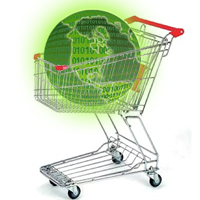I’ve had to locate good ecommerce software (online shopping carts, etc.) a few times for various projects. Each time the details of the project are different, which often requires using something entirely different. Here are some of the things you need to consider when shopping around.
 Try to pick the right product for the right platform. What server platform are you using? Pick the ecommerce application that fits in with everything else you’re doing and it will be a lot easier to integrate and maintain. If most of your site is running on Windows 2003 Server using ASP .NET and MS SQL, go with an ecommerce application that uses that. If on the other hand you’re running on Linux with PHP / MySQL pick something that fits in. Most popular cart apps are written in either PHP or ASP. I generally avoid anything that is written in its own proprietary scripting language. While it may be more secure and flexible it usually just ends up more difficult to maintain. It’s just easier to do everything with a common language since you might find yourself pulling in data from the cart in other places around your site. Also, applications written in common scripting languages often have larger communities dedicated to using and extending the product.
Try to pick the right product for the right platform. What server platform are you using? Pick the ecommerce application that fits in with everything else you’re doing and it will be a lot easier to integrate and maintain. If most of your site is running on Windows 2003 Server using ASP .NET and MS SQL, go with an ecommerce application that uses that. If on the other hand you’re running on Linux with PHP / MySQL pick something that fits in. Most popular cart apps are written in either PHP or ASP. I generally avoid anything that is written in its own proprietary scripting language. While it may be more secure and flexible it usually just ends up more difficult to maintain. It’s just easier to do everything with a common language since you might find yourself pulling in data from the cart in other places around your site. Also, applications written in common scripting languages often have larger communities dedicated to using and extending the product.- Consider the software license. Examine the license agreement. What kind of license do you get? What are you allowed to do? How many times can you install the application? What are the limitations? Many popular ecommerce solutions like OsCommerce are open source, which means that not only is it free to download, but you can do whatever you like with it. Some will allow you to install multiple times if you buy one license, others will only let you install and use once. I had a situation recently where we purchased a license for an application we’re using and later found out the license only allows for one install, even on the same domain, so we couldn’t install it twice on the same site even for non-public use. This was annoying, especially considering it was not an inexpensive product.
- What payment types are supported? How will you be accepting payment? Paypal, credit cards, egold, etc.? If you plan to take credit cards, you’ll need some sort of online payment processing gateway usually provided by companies like Authorize.net. Most ecommerce applications support Authorize.net and Paypal, but you should make sure you know two things: how you will be accepting payment, and are your desired forms of payment supported by the ecommerce application.
- How easy is it to template or reskin? This is a big one unless you don’t mind having a storefront with that looks like everyone else’s. One of the things you’ll notice about many of the ecommerce packages is that the end result always looks very similar. This is particularly true of many of the cheap and free alternatives like OsCommerce. You may have a different banner or background colors, but otherwise one OsCommerce site looks pretty much like another. Do some research on how easy it is to reskin or re-template the application output, especially if you want the storefront to be integrated into the look and feel of your website. When I’m looking at different products, I basically look for something that can spit a product listing into my overall site design. I stay away from stuff that has too many modules and extras because this tends to get in the way of reskinning. It also helps to visit sites that are using the product to see what they’ve done with it.
- What support is available? This is one of those things that is highly variable, but generally what kind of support will you get with the product. If it’s a free product, don’t be expecting any hand holding. Raise your expectation level as the price goes up. For any product, you’ll need to read the documentation. Look for good documentation and an active community when working with a free product. For more expensive products, do your research on what type of support is provided by the vendor. Many vendors will offer free installation or other services that will help you out. On the flip side, some companies specialize in nickel and diming you to death. They’ll sell you the base product for next to nothing, but the necessary payment modules and normally included functions will cost you 50-100% extra. If you want software upgrades and customer support you’ll need to pony up another 50-100%. Support can be a big deal and an added headache if it sucks.